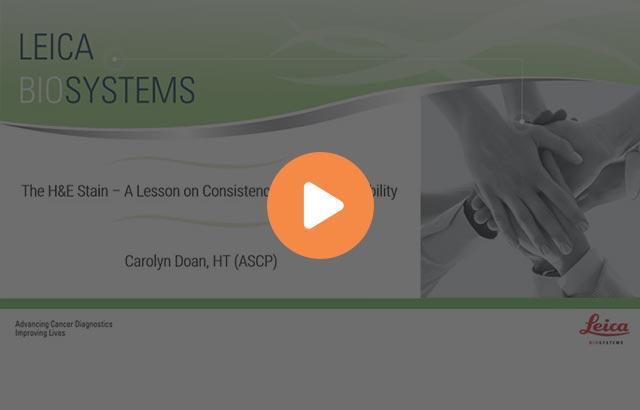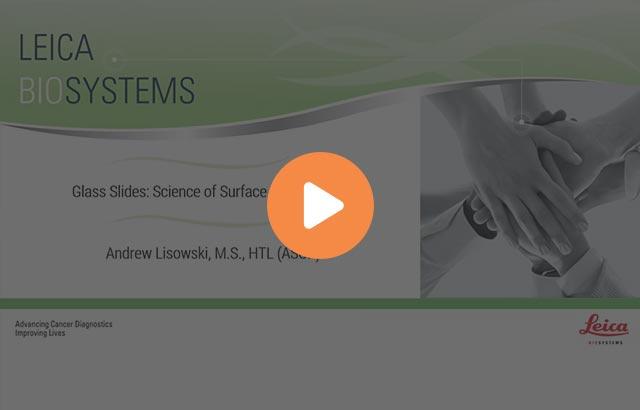Processing Fatty Specimens


One of the most critical steps in histology is fixation, especially when it comes to fatty tissue.
Learning Objectives
- Review the process of specimen handling before the processor
- Analyze the reasons why fatty specimens are so difficult to process
- Discuss the different technologies for processing and solutions used
- Identify good quality techniques for processing fatty specimens
Webinar Transcription
Slide 1
Processing Fatty Specimens. Let’s talk about our objectives.
Slide 2 - Learning Objectives
Throughout this presentation, we’re going to review the process of handling specimens, especially fatty specimens, before the processor. Next, we will analyze the reasons why fatty specimens are so difficult to process, and we also would like to discuss the different technologies. Finally, we will also identify good quality techniques for processing fatty specimens.
Slide 3 - Agenda
Today, we’re going to walk through the stages of tissue processing, from grossing all the way through infiltration.
Let’s start with grossing, one of the most important things in histology. If your specimen is not grossed properly, you’re not going to get the proper results that you’re looking for. The next step after grossing is going to be fixation.
Now, in the case of us presenting fatty tissue specimens today, I’m thinking more of breast specimens, so we do have to follow the CAP regulations about using neutral buffered formalin or NBF. Once we’re done with the fixation, we can speak to dehydration on the tissue processor and then talk about clearing reagents.
Next, we will speak to paraffin infiltration. This is so important because, there are numerous opinions about paraffin in the histology world. Last, but not least, we will focus on best practices for processing fatty specimens.
Slide 4 - Fatty Specimens; Why are they so difficult to process?
Fatty Specimens; why are they so difficult to process? It all comes down to fat being fundamentally hard to penetrate. This can lead to underfixation or underprocessing. Ultimately, often causing tissue that is difficult or even impossible to section. So, the question of today, what can we do to aid this process?
Slide 5 - Grossing
Well, first, it all starts in grossing. The specimens arrive into histology, have the proper identification and information about where the specimen taken from and a bit of patient history. Once checked, the grossing process can be initiated. With fatty tissue, it is imperative to select the most representative piece or pieces.
As we discussed earlier, fatty tissue is fundamentally hard to penetrate, so when selecting your representative piece of tissue, you will need to keep in mind that some trimming will be required. You want to get the specimen down to an ideal size. Optimally we have 1 to 2-millimeter biopsies for rapid processing , and we have 3 to 4 millimeters for routine overnight processing. Once selected and trimmed, special inking of margins may be needed, to maintain a visual cue of the potentially abnormal tissue. Also, important to remember, no oversized tissue should ever be forced into a cassette.
Slide 6 - Grossing Fatty Tissue
Cassette selection is also important. You can see that I have a picture here highlighting multiple types of cassettes. Importantly, when selecting a cassette, ensure there’s enough space in that cassette for fluid penetration throughout the tissue. If that cassette was totally filled there would be no room for a proper fluid penetration. The tissue is now ready for fixation.
Slide 7 - The Goal of Fixation
The goal of fixation is to create the matrix of cross-links to immobilize proteins that make up the tissue. As our body is made up of all kinds of proteins and lipids, carbohydrates, etc., creating a matrix of cross-links is incredibly important. Once we do that, we stop autolysis which is the self-destruction of the tissue. Stopping autolysis prevents the tissue from acting upon itself as well as breaks down those intracellular proteins that will also prevent decomposition.
Slide 8 - Fixation Process
Driving the fixation process, is a fixative agent. There are several criteria that can and should be used when selecting the proper fixative. First, a general or routine fixative could be used when demonstrating general morphology. Should specific cell types of cell constituents need to be demonstrated, special fixatives can and should be used to preserve these structures. For example, there are fixatives specifically recommended for dense tissue, called fix-all. Lastly, the choice of fixative must be compatible with later staining steps. For example, Immunohistochemistry vs. routine staining. In IHC, you will want to avoid or limit the time in formalin, which could inadvertently mask the antigen, generating a potentially false negative outcome.
What are some of the properties of a good fixative? It should penetrate cells rapidly, as fixation works from the outside in. When specifically speaking about fatty specimens, it often helps to cut them open and make sure that it has multiple points of entry into that specimen, so the middle and outer edges get fixed equally.
When dealing with fatty or elongated tissue, thin pieces of cork, stapled to fatty tissue can be used to immobile the tissue, ensuring that the fixative can penetrate the tissue evenly. The cork prevents curling and uneven fixation throughout the tissue.
Slide 9 - Issues with Improper Fixation
For reference, here is an image that highlights what can possibly happen when a large specimen isn’t fixed properly as a result of poor grossing practice. Please take a look at the picture on the right-hand side and there’s a little blue box.
What’s important is the pinkish area at the top of the uterus. The area is pink because it was not properly fixed. This could lead to an all too familiar conversation that goes something like this…
You are in the laboratory and you are approached by a pathologist. The pathologist brings you a slide, and states that everything is beautiful on this slide, except for one thing in one particular area. Then, you get the dreaded question, “why doesn’t this area look right? There’s a lot of distortion. The tissue doesn’t look fixed. I’m not sure how or why, because the rest of the slide looks so good.”
The reason it happened was because the specimen was likely improperly grossed and did not achieve fixation across all tissue.
Slide 10 - Variables Impacting Fixation
The other thing to remember are the variables that can impact fixation. First is the choice of fixative. For example, once you open up a bottle of NBF, it starts crosslinking to itself. This can impact downstream results. Next, the volume ratios are important. You should have a minimum of 1:10 tissue to fixative ratio, ideally 1:20. This should help ensure optimal slides and images. Next, Tissue thickness is also an important variable, as it can impact the migration to the center of the tissue. While 4 mm would be ideal, when dealing with fatty specimens, the thinner the tissue, the better. Target 2 mm if possible. Many of the chemicals that we are speaking about have trouble penetrating the fatty layer, so the thinner, the better.
Slide 11 - Fixation Considerations
When looking at desirable properties of fixatives, we are focused on the following. First, the fixative should provide reproducible and consistent results. When fixing tissue, we know that the tissue will shrink inside formalin, up to 10%, but what is more important is that cross-linking of the tissue results in sufficient hardening to retain cellular components. So, when you have successful crosslinking, the tissue hardens. To reinforce, formalin crosslinks proteins. Once the fixation is set, decomposition is going to stop.
Lastly, all fixatives should inactivate enzymes, kill bacteria and viruses, and enhance downstream staining properties.
Slide 12 - Fixation of Fatty Tissue
One of the most common fixatives is formalin. Formalin is aqueous solution of formaldehyde. 10% formalin contains approximately 4% formaldehyde. The formalin needs to be buffered to a pH of 6.8 – 7.2 and to do this, buffered salts are added. The reason this is so important, is if formalin is not buffered, it will leave a pigment behind. Additionally, methanol is also added to minimize polymerization of formaldehyde molecules.
As we are speaking about fatty specimens, it is interesting to note that formalin is a required fixative for HER2/NEU staining.
Another common fixative used for processing fatty tissue is alcoholic formalin. It can be used as a secondary fixative and the good thing about alcoholic formalin; not only is it a fixative, but it’s a fixative that’s been mixed with alcohol, so there’s some dehydration going on at this time. That might help the specimen and potentially have a positive impact when fixing fatty specimens. The benefit of this 50/50 mix of alcohol and formalin is alcohol is slowly introduced to the tissue. When you process this delicate tissue downstream, adding an intermediate step, in alcoholic formalin, helps the tissue to not be “shocked”.
Slide 13 - Dehydration
After fixation is the process of dehydration. To dehydrate samples, typically a series of gradually increasing percentages of alcohols are used. Let’s start here. Commonly used alcohols in dehydration are: ethanol, reagent alcohols, methanol and isopropyl alcohol.
Importantly, the type of alcohol used in dehydration can have an impact on downstream staining. For example, the staining is going to be very different between methanol and isopropanol. Specifically, methanol will produce grayer hematoxylin and paler eosin results. In dehydration, the water slowly is replaced with alcohol and we always need to start with a low volume of alcohol. Let’s say 70%. This is important, because if you start from anything higher than 70%, you will likely create salts in your tissue processor.
At the end of this process, the result will be 3 to 4% water left in the tissue. That’s the bound water, or water in tissue which is bound to the cell structures. Bound water is important, especially when time to section our specimens cleanly on the microtome.
Regarding options for dehydration, there are a few that we will speak about today. First is Ethanol. When used for processing, ethanol can be quite expensive and require a special license to purchase and maintain. However, there are numerous alternate options. The most common alternative is reagent grade alcohol. Reagent grade alcohol is made up of 90% ethanol, 5% methanol and 5% isopropanol or IPA. Importantly, reagent alcohols are not classified as controlled substances, due to the methanol component, and therefore do not require record keeping.
Lastly, Isopropanol by itself is rarely used as a dehydrant for xylene processing, however it can be used in xylene-free & microwave processing. When used in rapid processing, conventional or microwave, it removes the need for a clearing agent. Effectively, Isopropanol can replace xylene in xylene-free processing.
Slide 14 - Dehydration Using Xylene-Free Protocols
Let’s talk about dehydration process, using xylene-free protocol featuring isopropyl alcohol or IPA. For your xylene-free protocols you will likely have two steps of 80/20 ethanol/isopropanol mix followed by three steps of absolute isopropanol.
Since Xylene is a relatively hazardous solvent, laboratories are under pressure to seek less toxic alternatives for routine use. A xylene-free method has been developed that excludes xylene, not only as a processing step, but for deparaffinization steps during routine staining. During the processing, clearing with xylene is replaced with 80% mixture of ethanol and IPA. Lastly, heat can be added to some or all of the protocol steps. It is important to consider the size of the tissue, as larger tissue will require more heated steps.
Slide 15 - Clearing
We’ve now arrived at the clearing step. Clearing is the intermediate step between dehydration and paraffin infiltration and the purpose is to displace alcohol in the tissue.
When selecting a clearing agent, it is important to select an agent that does not over harden the tissue and be miscible with both the dehydrating reagent and the infiltration media.
One interesting anecdote, the process of clearing was originally termed as such, because the reagents used for this step have a high index of refraction and will render the tissue transparent.
Slide 16 - Clearing Reagents
When clearing, it is also important to think about the selection of reagents. Most commonly, Xylene and xylene substitutes. First, let’s talk about xylene.
Xylene is the most commonly used reagent for cleaning. Reasons being that Xylene is typically more forgiving of under-dehydrated tissue and inexpensive to purchase, but unfortunately, xylene is quite expensive to discard. Furthermore, xylene is a highly flammable and hazardous substance. Prolonged exposure can cause hardness and brittleness to the tissue. Lastly, xylene doesn’t mix with water.
Because of these issues, xylene substitutes are commonly chosen for implementation into the laboratory process. Why? Because they’re better for our health, and better for our tissue. Typically, they are safer, gentler and most are non-flammable. The benefit is they often do not cause hardness or brittleness compared to Xylene. One point of interest….“Delimoning” like xylene substitutes are very oily and thick, and for that reason, some manufacturers do not recommend their use in the lab.
The tradeoff for using xylene substitutes is a reduction in efficacy, important, because you must change/rotate them more often due to carryover and the fact that they stop working properly.
Slide 17 - Infiltration
After clearing is the paraffin or infiltration step. Paraffin supports and provides a matrix to the tissue once the tissue has completed processing.
There are different types of paraffin on the market, each with a different melting point, generally resulting from different polymer content.
During the processing stage, it is critical to select the paraffin that is optimal for processing as opposed to paraffin that is optimal for embedding. Processing paraffins generally do not contain a lot of polymers and may contain additives such as DMSO. Interestingly, when DMSO is added to hand lotions, the time required for the lotion to penetrate the skin and dry is significantly less than lotions without DMSO, highlighting its efficacy. The same is true when processing tissue.
In contrast, embedding paraffins generally contain a lot of polymers, to provide a better support and matrix for sectioning and ultrathin sectioning.
Slide 18 - Best Practice: Processing Fatty Speciments
So, how do we put this all together. There are a few tips and tricks to consider when processing fatty tissue.
(Say the numbers)
- When grossing fatty tissue, when possible, ensure the thinnest tissue possible
- Target 2 mm tissue thickness for better reagent penetration
- If possible, chose an optimal fixative, ideally containing alcohol
- Staple tissue to a cork during fixation, to minimize folding and ensure fixative accessibility
- Alternately, score the tissue to allow fixative to penetrate the tissue
Slide 19
Best Practice: Processing Fatty Specimens
- Use cassettes with larger diameter holes to drive optimal fluid exchange
- Very thick fatty specimens may require a longer protocol
- Add a defatting step
- A defatting step will typically use a 50/50 mixture of xylene and ethanol. It is critical to add this step in between the ethanols and xylene steps. You must also ensure 100% ethanol steps are completed after the defatting step and before the xylene steps.
- Choosing optimal paraffin:
- When choosing optimal paraffin, remember that different paraffins are helpful at different stages of the process. For example, processing paraffins need to be optimal for infiltration and contain things like DMSO. However, embedding paraffins need to be optimal for support and providing structure, often containing high levels of polymer).
Slide 20 - Conclusion
In review, we’ve reviewed the process of handling specimens, especially fatty specimens, before the processor. Next, we analyzed the reasons why fatty specimens are so difficult to process and discussed the different technologies and reagents for tissue processing. Finally, we identified good quality techniques for processing fatty specimens. Thank you for your time today and we hope you found this session useful.
About the presenters

Andrew Lisowski has almost 30 years of experience in histology and histotechnology. He attended veterinary school and earned his master’s degree in molecular biology. Andrew worked in histology, IHC and ISH labs, cell culture lab, performed in-vitro and in-vivo toxicology assays and was a member of a necropsy team. He worked for pharmaceutical companies, medical school and founded his own molecular and histology firms.

Adam Walter at Leica Biosystems is a Certified Six Sigma Master Black Belt and Certified Lean Agent. Adam has worked with over 500 facilities, spanning across the globe, focused on optimizing efficiency, improving quality and integrating automation into clinical workflow processes. His work has traversed a majority of the clinical and anatomic laboratory, as well as hospital departments such as pharmacy, chemotherapy preparation and supply chain. He has multiple publications in the space of workflow and automation as well as authoring industry guidelines relating to laboratory design and architecture.
Related Content
Leica Biosystems Knowledge Pathway content is subject to the Leica Biosystems website terms of use, available at: Legal Notice. The content, including webinars, training presentations and related materials is intended to provide general information regarding particular subjects of interest to health care professionals and is not intended to be, and should not be construed as, medical, regulatory or legal advice. The views and opinions expressed in any third-party content reflect the personal views and opinions of the speaker(s)/author(s) and do not necessarily represent or reflect the views or opinions of Leica Biosystems, its employees or agents. Any links contained in the content which provides access to third party resources or content is provided for convenience only.
For the use of any product, the applicable product documentation, including information guides, inserts and operation manuals should be consulted.
Copyright © 2025 Leica Biosystems division of Leica Microsystems, Inc. and its Leica Biosystems affiliates. All rights reserved. LEICA and the Leica Logo are registered trademarks of Leica Microsystems IR GmbH.



